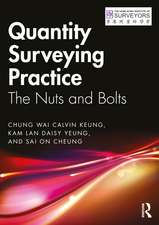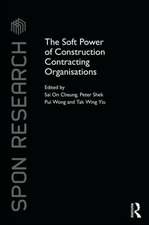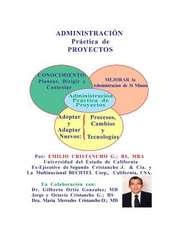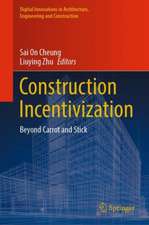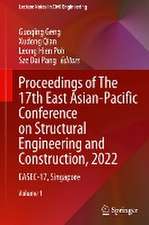Construction Dispute Research: Conceptualisation, Avoidance and Resolution
Editat de Sai On Cheungen Limba Engleză Paperback – 3 sep 2016
The book has twenty chapters that are arranged in four parts covering conceptualisation, avoidance, negotiation and mediation. Part 1 is devoted for dispute conceptualisation. A building is only as strong as its foundation. Thus it is no better start to study construction dispute by conceptualisation. The theme of Part 2 is dispute avoidance. The conventional wisdom of ‘prevention is better than cure’ seems can be applied to all problems. As far as construction dispute is concerned, equitable risk allocation and trust are the two most commonly accepted avoidance strategies. Part 3 focuses on negotiation that is the gateway to resolution as almost all disputes are negotiated first before the service of other mechanisms. Negotiation is sometimes described as an art because settlement may not be obtained solely from legal and rational approaches. Part 3 discusses the behavioral dimensions of construction dispute negotiation. Part 4 deals with Mediation- a form of assisted negotiation. Specially, the skill of the mediators in facilitating settlement, the interrelationships among dispute sources, mediator tactics and mediation outcomes are explored.
The studies presented in Construction Dispute Research collectively demonstrate holistic approach in dispute management. Each chapter can be read as a study on its own. Practitioners will find the book a handy reference in dispute management and resolution. Students would find the book useful in explaining in details the causes of dispute, the processes to resolve them. The research design and empirical approaches are particularly useful to students in construction management, architectural, surveying and civil engineering programs.
| Toate formatele și edițiile | Preț | Express |
|---|---|---|
| Paperback (1) | 646.75 lei 6-8 săpt. | |
| Springer International Publishing – 3 sep 2016 | 646.75 lei 6-8 săpt. | |
| Hardback (1) | 653.14 lei 6-8 săpt. | |
| Springer International Publishing – 14 mar 2014 | 653.14 lei 6-8 săpt. |
Preț: 646.75 lei
Preț vechi: 760.88 lei
-15% Nou
Puncte Express: 970
Preț estimativ în valută:
123.75€ • 134.85$ • 104.28£
123.75€ • 134.85$ • 104.28£
Carte tipărită la comandă
Livrare economică 23 aprilie-07 mai
Preluare comenzi: 021 569.72.76
Specificații
ISBN-13: 9783319347288
ISBN-10: 3319347284
Pagini: 425
Ilustrații: XV, 410 p. 80 illus.
Dimensiuni: 155 x 235 x 22 mm
Greutate: 0.59 kg
Ediția:Softcover reprint of the original 1st ed. 2014
Editura: Springer International Publishing
Colecția Springer
Locul publicării:Cham, Switzerland
ISBN-10: 3319347284
Pagini: 425
Ilustrații: XV, 410 p. 80 illus.
Dimensiuni: 155 x 235 x 22 mm
Greutate: 0.59 kg
Ediția:Softcover reprint of the original 1st ed. 2014
Editura: Springer International Publishing
Colecția Springer
Locul publicării:Cham, Switzerland
Cuprins
Construction Contracts.- Contracting: Minefield of Construction Disputes.- Analyzing Construction Dispute.- Negotiating Construction Dispute.- Mediation as a Form of Assisted Negotiation.
Notă biografică
Prof. Cheung is the Assistant Head and Professor in Department of Civil and Architectural Engineering, City University of Hong Kong. Building on his industrial experience in contract administration, Professor Cheung has developed research programmes in contract and dispute management. Prof. Cheung is the Head of the Construction Dispute Resolution Research Unit (CDRRU) and specialty editor (Contracting) of the ASCE Journal of Construction Engineering and Management.
Textul de pe ultima copertă
There are three specific purposes of Construction Dispute Research. First, this volume aims to summarise studies on construction dispute. Second, apart from the theoretical constructs, where appropriate empirical tests are also included. This approach serves to go beyond the commonly used anecdotal approach for the subject matters. Third, it is the sincere hope of the authors that this book will help shaping research agenda of construction dispute. The studies are mostly framed from a management perspective drawing on methods and concepts in contract law, economics, psychology and management science.
The book has twenty chapters that are arranged in four parts covering conceptualisation, avoidance, negotiation and mediation. Part 1 is devoted for dispute conceptualisation. A building is only as strong as its foundation. Thus it is no better start to study construction dispute by conceptualisation. The theme of Part 2 is dispute avoidance. The conventional wisdom of ‘prevention is better than cure’ seems can be applied to all problems. As far as construction dispute is concerned, equitable risk allocation and trust are the two most commonly accepted avoidance strategies. Part 3 focuses on negotiation that is the gateway to resolution as almost all disputes are negotiated first before the service of other mechanisms. Negotiation is sometimes described as an art because settlement may not be obtained solely from legal and rational approaches. Part 3 discusses the behavioral dimensions of construction dispute negotiation. Part 4 deals with Mediation- a form of assisted negotiation. Specially, the skill of the mediators in facilitating settlement, the interrelationships among dispute sources, mediator tactics and mediation outcomes are explored.
The studies presented in Construction Dispute Research collectively demonstrate holistic approach in dispute management. Each chapter can be read as a study on its own. Practitioners will find the book a handy reference in dispute management and resolution. Students would find the book useful in explaining in details the causes of dispute, the processes to resolve them. The research design and empirical approaches are particularly useful to students in construction management, architectural, surveying and civil engineering programs.
The book has twenty chapters that are arranged in four parts covering conceptualisation, avoidance, negotiation and mediation. Part 1 is devoted for dispute conceptualisation. A building is only as strong as its foundation. Thus it is no better start to study construction dispute by conceptualisation. The theme of Part 2 is dispute avoidance. The conventional wisdom of ‘prevention is better than cure’ seems can be applied to all problems. As far as construction dispute is concerned, equitable risk allocation and trust are the two most commonly accepted avoidance strategies. Part 3 focuses on negotiation that is the gateway to resolution as almost all disputes are negotiated first before the service of other mechanisms. Negotiation is sometimes described as an art because settlement may not be obtained solely from legal and rational approaches. Part 3 discusses the behavioral dimensions of construction dispute negotiation. Part 4 deals with Mediation- a form of assisted negotiation. Specially, the skill of the mediators in facilitating settlement, the interrelationships among dispute sources, mediator tactics and mediation outcomes are explored.
The studies presented in Construction Dispute Research collectively demonstrate holistic approach in dispute management. Each chapter can be read as a study on its own. Practitioners will find the book a handy reference in dispute management and resolution. Students would find the book useful in explaining in details the causes of dispute, the processes to resolve them. The research design and empirical approaches are particularly useful to students in construction management, architectural, surveying and civil engineering programs.
Caracteristici
Extended discussion on the use of negotiation and mediation for construction disputes settlement Real life examples (labour strike of steel bar benders) enhance reader understanding and add a significant dimension The studies are theory-rich and leads to important conceptualizations that are not commonly employed in construction dispute studies Includes supplementary material: sn.pub/extras










